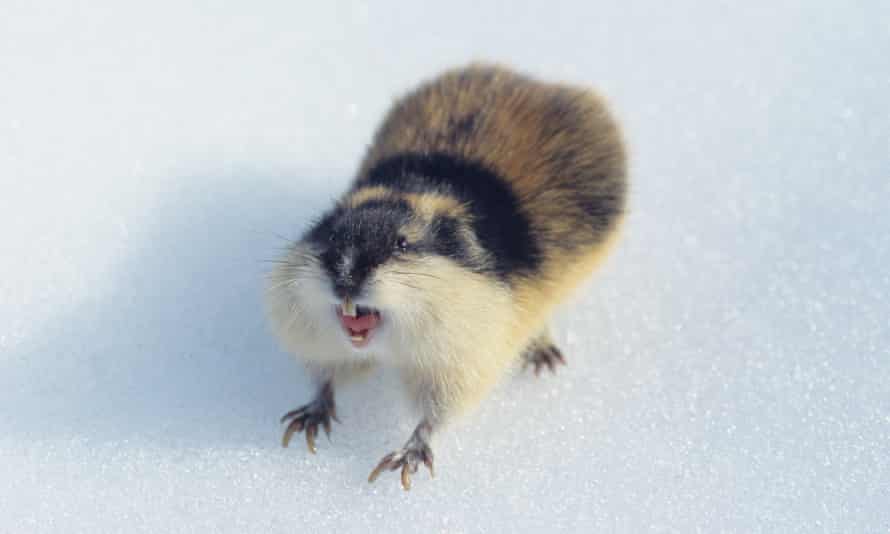A Norwegian lemming looks like a larger, slightly cleverer and much more irate hamster. Their underside fur is biscuit-coloured. On top they wear a mottled calico.
The BBC, in a 2015 documentary episode in which a lemming repeatedly charges a full-sized house cat – and then attacks the rock on to which the house cat has leapt in fear – called them “bloodthirsty, hairy berserkers”.
“They have been known,” we are told as the screen shows a lemming, surrounded by plum-coloured leaves, baring its rodent teeth and squeak-barking at the camera, “to kill weasels and fight off skua.” (Skua are aggressive, seagull-like birds.)
Wait. Aren’t lemmings so meek and stupid that they march en masse to their deaths, throwing themselves off cliffs without a thought?
As it turns out, no: lemmings “acting like lemmings” is a myth, as Sonia Shah explains in her book, The Next Great Migration. Lemmings do not practise mass suicide by jumping into the sea. When asked to join the death cult, they squeak-bark, “No!” They refuse the poisoned Kool-Aid.
Lemmings live in tunnels under the snow, sleeping in cosy nests of grass, feathers and musk ox wool. Their young are bred in a layer of air formed by warm ground melting the snow just above it, called the “subnivean space”.
When the snow melts in summer, it floods their burrows and they emerge all at once – the inspiration for another myth, that they plop down miraculously from the sky – blink their eyes at the blurry Nordic sun, and begin to move, like several Roombas over which someone has thrown a grisly fur coat, hoovering up every sedge, grass and moss frond in sight.
“What were these mice that we could not conquer them?” asked the poet Oscar Brynes in 1934.
Little that is edible stands in the lemmings’ way, and “In their turn they are pursued and harassed by crowds of beasts and birds of prey, bears, wolves, foxes, dogs, wild cats, stoats, weasels, eagles, hawks, and owls,” according to the 1902 Encyclopedia Britannica. “Even domestic animals such as cattle, goats and reindeer join in the destruction, stamping them to the ground with their feet.”

Where are they marching? Towards the sea in search of the lost city of Atlantis, their drowned home? Every few years, their population grows by so much (1,000 fold) that a group of them – one can imagine the chosen ones spitting with fury under their breath that they have to be the lemmings to do it – separates from the rest of the group and migrates. They are good swimmers but sometimes misjudge the breadth of the cold water and drown.
The collective suicide myth persists because Disney staged one in the 1958 documentary White Wilderness. As someone off-screen tips several imported lemmings off a riverbank in Canada, the bloodthirsty voiceover narrates: “Tiny avalanches of soil and rocks – and seemingly indestructible lemmings.”
The lemmings didn’t jump – they were pushed.
In the children’s tale, Read the Book, Lemmings, the lemmings keep jumping into the sea because they think it’s what they are meant to do. If only they would read the book they would learn that they are not driven unstoppably towards death.
It is a sobering thought for anyone: that reading just the right book might stop us taking things quite so seriously, getting quite so worked up at house cats, flinging ourselves off the precipice quite so often. There is a pocket of air between the cold snow and the warm ground where much of life can be light and funny, if you let it.
People might still be saved from literally exploding with anger, as some believe lemmings do. It is unlikely for Lemmus lemmus. The BBC, again: “A person walking across the meadow would cause the lemmings, several metres away, to give themselves away by unexpectedly shrieking and jumping about,” they quote a group of researchers as writing.
“Even the farm tractor was greeted in this way, leaving a trail of infuriated lemmings behind.”
“The Nature of …” is a column dedicated to interesting animals, insects, plants and natural phenomena. Is there an intriguing creature or particularly lively plant you think would delight our readers? Let us know on Twitter @helenrsullivan or via email: helen.sullivan@theguardian.com